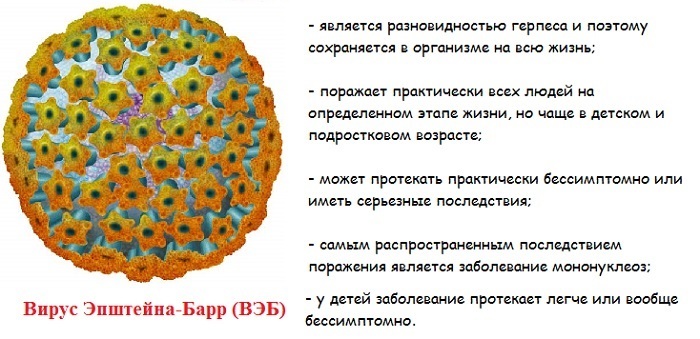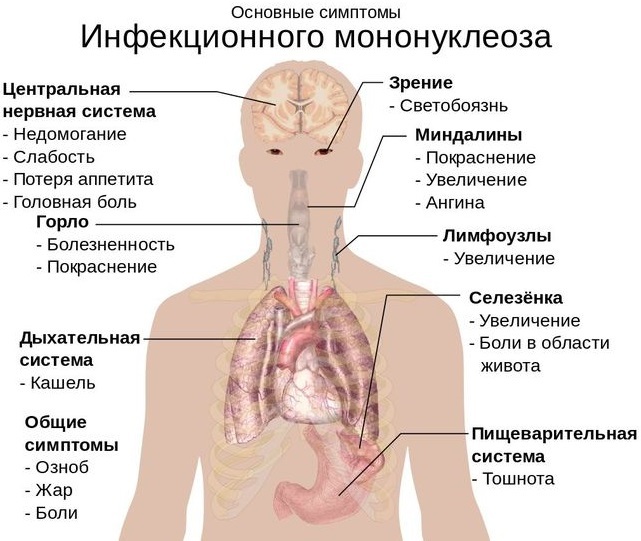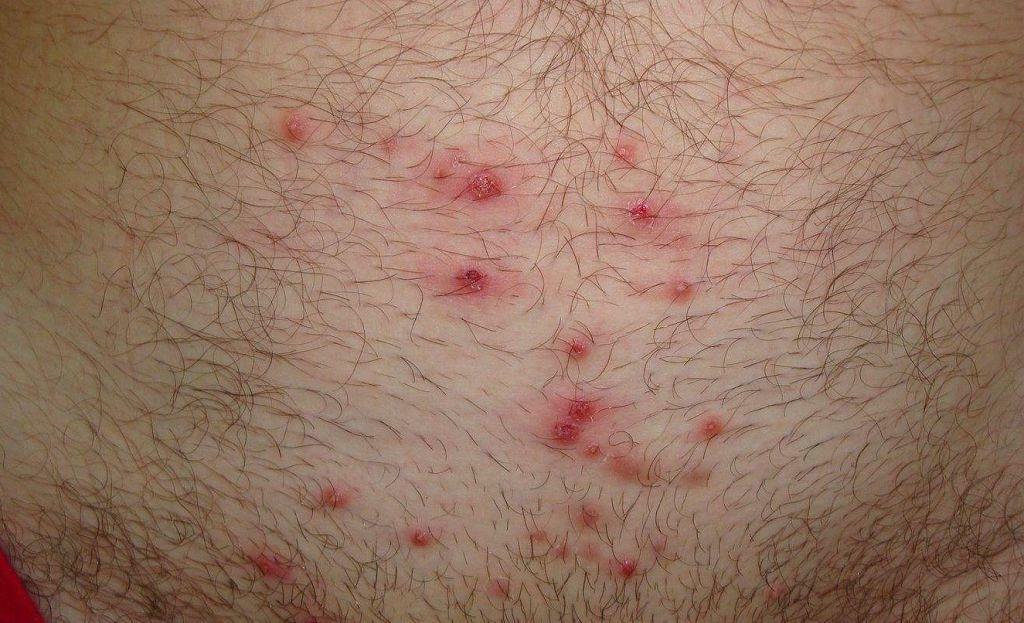Mononucleosis refers to infections, which often affects children and adolescents. Symptomatology is common manifestation, which complicates diagnosis.
The main difference from other diseases, is the defeat of the internal organs, thus avoiding the development of flu or a sore throat. Adults often develop immunity to the virus, so the risk of not making.
The content of the article:
- 1 Infectious mononucleosis: that is, the classification
- 2 How does the virus mononucleosis
- 3 Symptoms of infectious mononucleosis in adults
- 4 Diagnosis of infectious mononucleosis in adults
- 5 Prevention of infectious mononucleosis in adults
-
6 Methods of treatment of infectious mononucleosis in adults
- 6.1 medication
- 7 Diet
- 8 Physical exercise
- 9 Hospitalization
- 10 complications
- 11 Video of infectious mononuleoze
Infectious mononucleosis: that is, the classification
Infectious mononucleosis is expressed in acute viral infection. In the course of the disease affects the oral cavity, lymph nodes, spleen and liver. The diagnosis is the presence in the blood mononuclear cells.
Mononucleosis is a common disease and is caused by Epstein-Barr virus. The virus discovered in 1964, during its existence, found that 90% of people are present in the blood of antibodies to the causative agent of the disease.
At risk are children, adolescents, pregnant women and people with weak immune systems. Infectious mononucleosis is subjected to successful treatment, provided timely diagnosis.
Medical classification distinguishes these types of mononucleosis:
- Typical.
- Atypical (asymptomatic, visceral or erased).
According to the severity of the disease:
- Mild form.
- Average.
- Heavy.
The character of the disease:
- Smooth.
- Nonsmooth (if complications reinfection or overflow in the chronic form).
flow length:
- acute mononucleosis-up to 3 months;
- prolonged-up to six months;
- Chronic-more than 6 months.
How does the virus mononucleosis
After penetration into the respiratory tract, the virus infects epithelial integument and lymphatic system of the mouth and throat. As a result, mucosal edema.
The pathogen-Epstein-Barr virus belongs to the herpes type. In most cases, it enters the body through saliva (hence believe that the sick often from kissing).
Initially, the virus is in a person's mouth, then affects the lymph tissue and into the B-lymphocytes. As a result, the person gets swelling of the mouth and throat, tonsils and significantly increased lymph nodes.
Getting into the B-lymphocytes the virus spreads throughout the body, some time in the patient and increases the functionality is broken liver and spleen.
The causes of infectious mononucleosis in adults
Infectious mononucleosis in adults and children takes place in close communication with the patient, that is airborne. Through saliva during kissing, through blood transfusion, using other people's personal care products, as well as by public transport. The symptomatology is similar to other diseases, so it is important to see a doctor in time.
A large part of the population suffers mononucleosis in adolescence, because the child's body is unformed immunity. The incubation period is 5-20 days.
Girls often catches the disease at the age of 14-16 years and boys 16-18 years. developed antibodies to this virus, so sick after 40 years is almost impossible in the blood of adults.
The infection has an acute development due to the fact that during the first wave of the disease killed many cells that the virus grabs.

Teenagers and children are often infected by airborne droplets, as well as using other people's things. The virus can be placed not only on toys, bottle, but also bedding, clothes, towel. Children attending kindergarten and school, more likely to suffer from mononucleosis, since most of the day carried out in the general team, where there may be a carrier of the virus.
Due to the lack of vitamins and unstable weather, the season of the disease accounts for the period of autumn and spring.
During pregnancy, the disease is rare, but can occur on the background of these conditions:
- in the case of frequent hypothermia women;
- due to a weak immune system against the background of HIV infection;
- If a woman's body is a hotbed of the disease;
- beriberi availability and lack of trace elements to maintain immunity;
- Chronic diseases, such as diabetes.
Often the mononucleosis virus is not dangerous to the health and development of the fetus, but the danger lies in the symptoms that accompanied during his illness. In the presence of the above factors, the pregnant woman should be very careful, since at any moment can flare exacerbation mononucleosis.
Doctors found that in the normal course of the disease, mononucleosis is not dangerous to the fetus. It does not cause malformations in narozhdonnogo child and does not become a threat to abortion.
After this illness, pregnant women are advised not immediately return to the normal rhythm of life. This is due to low immunity and the risk of catching a new infection. Therefore, some time should stay home and avoid contact with lots of people.
If a woman has picked up the virus during pregnancy planning, the birth is delayed until recovery. This is due to the fact that mononucleosis can cause hepatitis, which is dangerous for childbearing.
Symptoms of infectious mononucleosis in adults
Infectious mononucleosis in adults, the symptoms of which are similar to the first, with a sore throat, including pain on swallowing and speaking, fatigue, dizziness and nausea. Gradually added fever, swelling of lymph nodes, congestion in the nose.
During the first week there may be enlargement of internal organs, blood visible atypical mononuclear cells. Severe disease is characterized by swelling of the eyelids, and also the presence of rash in the abdomen and face.
Oropharyngeal virus affects overall, which leads to swelling of the palate and tonsils. The patient feels discomfort in breathing, changes tone of voice, inspiratory crackles audible. Nasal congestion is not accompanied by an active discharge of mucus, as in standard colds.
The children, on the palate and tonsils observed plaque from the first days of illness. Initially, it completely covers the bodies a few days later takes the form of stripes or islands. The appearance of plaque often causes the temperature to rise to 39-40 ° C.
One of the main signs of mononucleosis, is considered to be a defeat of the liver and spleen. Every day, the body increases in size, which leads to yellowing of the skin and whites of the eyes. If successful, the treatment, the bodies are recovered within two months, in rare cases, the increase is still 3-4 months.
At the peak of the disease is often a rash that may have such a character:
- hives;
- hemorrhagic;
- morbilliform;
- skarlatinoobraznaya.
In rare cases, petechial hemorrhages may act on the palate. In the heart of serious violations were noted. Perhaps the appearance of systolic murmur and tachycardia.
Infectious mononucleosis in adults, symptoms and inflammation, which are after 1.5-3 weeks of treatment. But the presence in the blood mononuclear cells antipichnyh may remain for some time.
Diagnosis of infectious mononucleosis in adults
Infectious mononucleosis in adults, the symptoms of which are developing faster than in children, can lead to several complications.
Therefore, when the first symptoms of mononucleosis patients were administered a comprehensive survey for an accurate diagnosis. At first, the symptoms may be similar in nature to other viral symptoms, so it is important to exclude a number of other diseases.
- To identify the clinical picture of the patient referred to a therapist or Laura. Initially, history is going, where symptoms and the condition of the patient described.

- The main tests for the detection of the virus are: throat swab and blood test. The latter gives the exact answer, whether the person has mononucleosis, since this disease is characterized by a specific body in the blood.
- smear study was conducted to exclude the presence of angina, since mononucleosis bacteria bakloseve no.
- A blood test administered several times. This is due to the fact that the initial form of the virus does not change the composition of the blood, abnormal cells appear a few days later.
- With pharyngoscope investigated oral cavity, the degree of redness and the presence of enlarged tonsils plaque.
- Palpation determine the state of the lymph nodes, in the step of developing the disease, they are enlarged.
- Also palpation overtures liver and spleen. During the procedure, the patient may feel pain.
- Are inspected to detect skin rash.
Prevention of infectious mononucleosis in adults
As a precaution recommended to adhere to the following rules:
- strengthen the immune system. To do this, eat right, exercise, drink a sufficient amount of vitamins, avoid nervous and stressful situations;
- avoid promiscuity;
- It is less in areas with large numbers of people. When you need to visit or work in such places, it is advisable to use mask and ventilate the room;

- do not use other people's personal hygiene;
- when the first signs of illness should contact a physician. You can not self-medicate, as mononucleosis may have serious consequences, which are very difficult to get rid of.
Methods of treatment of infectious mononucleosis in adults
During the treatment of mononucleosis main rule is to comply with bed rest, until full recovery. Hospitalization is carried only in the event of complications in the normal course of the disease, the patient left the house.
medication
In the treatment of mononucleosis is no special treatment, so the need for a comprehensive approach
For removal of inflammation and swelling of the oral cavity is used:
- "Valtrex". The course of treatment for 7 days, 1 tablet 2 times per day.
-
"Acyclovir". The course of treatment lasts for 5-8 days. Take 1 tablet 5 times a day.

- "Groprinosin". The course of treatment an average of 5-10 days before symptoms start to fade. Apply 2 tablets 3-4 times a day after meals.
Rinsing is carried out by means of:
- "Chlorhexidine", "Miramistin". Rinse takes 1 tablespoon of the drug. The procedure was carried out for 30 seconds, after which there is not recommended for an hour.
- A decoction of sage and chamomile.
To remove the appointed temperature:
- "Paracetamol". The course of treatment should not exceed 7 days. Recommended for use after meals and 1 tablet, 3 times a day.
- "Efferalgan". Tablet pre-dissolved in water and consume 2-3 times per day. Lasting acceptance to 5 days.
- As the folk remedies suitable: broth mint, chamomile, fennel or hips.
To strengthen the immune system and to give strength body, appointed by the intake of vitamins:
- "Revit";
- "Doppelgerts Active".
It is important to strengthen and support therapy. It is recommended to drink as much liquid as possible. This can be: tea, fresh juices (not acidic), tincture of herbs.
To maintain microflora appointed bifidobacteria and vitamin complex. Tea of lime and lemon balm will help calm the nervous system, enhances sleep and relieves intoxication. It helps fight swelling decoction of calamus or ginger.
Diet
Due to liver disease, mononucleosis when you need to adjust your diet. The best option is eating small meals, but every 3-4 hours. In order not to injure the mucous membrane of the mouth and throat, dish and beverages should be warm.
For the period of illness and recovery, are excluded from the diet of fried, spicy and fatty foods. From cooking in a frying pan should also move away from the place of the steam processing and baking.
Are not allowed to accept foods that are high in fiber and salt.

The table lists the products that should be deleted from the diet, as well as those that are recommended to be used.
| Featured products | Exclude from the diet |
| Beverages | |
|
|
| First course | |
|
|
| Kashi | |
| |
| Meat | |
|
|
| Bakery products and desserts | |
|
|
| Vegetables and fruits | |
|
|
| Milk products | |
|
|
First breakfast:
- steam omelet;

- a piece of boiled fish;
- decoction of rose hips.
Lunch:
- cottage cheese;
- banana, pear or persimmon;
- kefir.
Dinner:
- buckwheat;
- boiled chicken;
- fresh juice.
Snack:
- vegetable soup;
- sliced fruit: banana, strawberry, orange;
- vegetable juice.
Snack:
- baked apples;

- yogurt.
Dinner:
- pasta;
- boiled eggs;
- banana mousse, yogurt and apple juice.
Physical exercise
Infectious mononucleosis in adults, the symptoms of which cause a serious blow to the human body needs proper treatment. At the time of illness and recovery process, the patient is assigned to bed rest. Desirable to avoid serious physical activity, weight lifting, as well as a long presence on the cold and heat.
Doctors recommend the use of therapeutic exercise. Where possible, better to go out into the fresh air and do there. If there is no desire to exercise, we can restrict hiking.
exercises options:
- Sitting on a chair or couch, run obliquely outwards. Feet are a little wider than shoulder width, arms down. The exercise is performed slowly, with an average pace of 5-10 times on each side.

- position of the body, as in the first exercise. Brushes are moved to the back of the head. It is necessary to make the body turns to the left and to the right. In turn, the left elbow touch the right edge and vice versa. Performed 5-7 times on each side.
- Starting position the same. Palm to put on their knees. On each count knee lift to the chin, can help himself with his hands. Should repeat 3-6 times on each leg.
- body position does not change. Brush placed on his shoulders. It is necessary to carry out the amplitude of rotation of the shoulder joint. Perform at 8 times forward and backward.
- Starting position is the same, the hands are at the waist. On the inhale left arm is put aside, at the same time deploying the body to the head. On the exhale, the body returns to its original position, also repeated on the right side. Perform 4-6 times.
Hospitalization
Mononucleosis Treatment in most cases takes place at home, only in severe condition or the presence of complications, the patient is sent to the hospital.
For hospitalization resort in such cases:
- with the presence of high temperature (39-40 ° C) for a long time;
- for fainting, vomiting, diarrhea, fever and migraine pain;
- In case of other infectious diseases;
- when a poliadenita the threat of asphyxiation.

At the hospital, the patient is prescribed a course of drugs, including droppers, when complications can be connected to additional hardware, which will support the patient's condition.
complications
Complications of infection can be avoided, if we draw the right treatment, but in some cases the disease is confused with the common cold and initially administered the wrong drugs.
- Complications of the viscera comprising: bleeding in the retina, the development of kidney inflammation, problems respiratory system, the appearance of festering wounds, mumps, pancreatitis, thyroid diseases, disruption of liver.
- At rupture of the spleen patient feels a sharp pain in the abdomen, along with this, bleeding occurs. Such a case can be lethal. In this case, carry out urgent hospitalization.
- Because liver damage, improper treatment can result in hepatitis. The destruction of liver cells occurs jaundice.

- In a number of complications arise meningitis. It is characterized by inflammation of the lining of the brain. Is a serious disease, the treatment is long and complicated process.
- The emergence of anemia.
- The presence of hallucinations, frequent depression, mental problems, Bell's palsy, encephalitis, inflammation of the brain.
In the treatment of infectious mononucleosis main factor is the timely treatment to the doctor, as well as compliance with set guidelines. With the right approach, the disease does not bear serious and dangerous consequences. Drug therapy involves the removal of all the inflammation and symptoms, as well as the restoration of the affected organs.
It should be remembered that this virus is a type gerpesovyh, because of what can not be completely cured. That is why, repeated relapses in adults are possible after a certain time.
To avoid repeated illness, it is necessary to support the immune system and carry a healthy lifestyle.
Registration of the article: Mila Friedan
Video of infectious mononuleoze
Elena Malysheva tell about infectious mononucleosis:



